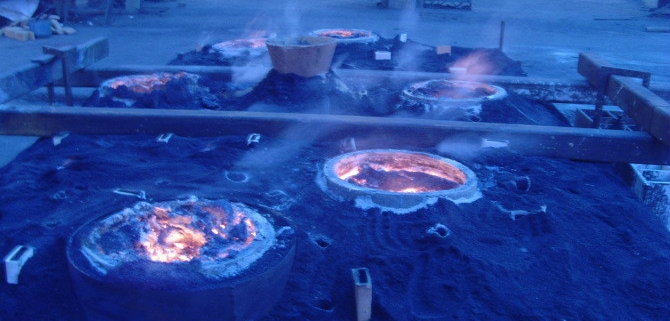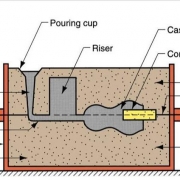GATING AND RISERING
Written by Rajesh. S M.
Tech Assistant Professor Department of mechanical Engineering Vemana Institute of Technology, Bangalore
1.CONCEPT OF GATING AND RISERING
•DEFINITION
•TYPES OF GATES
•GATING DESIGN
•GATING RATIO
•RISERING
•TYPES
•FUNCTIONS
2. ELEMENTS OF GATING SYSTEM
-
Pouring basin
-
Runner
-
Down sprue
-
Runner Extension
-
Sprue base
-
Gates
3.GATING
- Gating are flow passages to run and fill molten metal in mould cavity.
- Gating system include distribution of clean metal with proper rates and velocities at specific location in the mould.
4. TYPES OF GATING SYSTEM
-
Top gate
-
Bottom gate
-
Branch gate
-
Horn gate
-
Parting type
Top gate
Molten metal from pouring basin is fed directly into the mould cavity. • The hottest metal remains at the top of casting , this promotes directional solidification from the casting towards the gate
Bottom gate
The molten metal enters from bottom to the mould cavity. • It minimizes turbulence and erosion in the mould cavity. • Provides unfavorable temperature gradients that do not promote directional solidification.
Horn gate
This type of gate which is a part of the pattern with smooth curves and progressive change in dimension is designed to minimize mould erosion and oxidation of molten metal.
Parting type
It is most commonly used gate and is a compromise between top and bottom gates. • The gate is provided at the parting line of the mould .
Risering
A riser or feeder head is a vertical passage made in the cope to store the liquid metal and supply the same to the casting as it solidifies. Functions: • Store sufficient liquid metal and supply the same to the casting it solidifies there by avoiding volumetric shrinkage of the casting. • The riser must be kept open to the atmosphere and placed in such a location that it maintains a positive pressure of liquid metal on all portions of the casting it is intended to feed. • The cylindrical shaped riser are generally recommended compared to spherical shaped risers which although consider as the best.
Types of riser
1. Open riser • The top surface of the riser will be open to the atmosphere. • The open riser is usually placed on the top of the casting. • Gravity and atmospheric pressure causes the liquid metal in the riser to flow into the solidifying casting.
2. Blinder riser • It is completely enclosed in the mould and not exposed to the atmosphere . • The metals cools slower and stay longer promoting directional solidification. • The liquid metal is fed to solidifying casting under the force of gravity alone.



